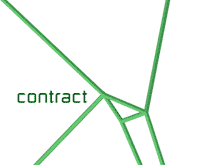contact
by Aya Kaprinska
|
Working
Note: contract
is the second poem I have What conventions can we retain from two-dimensional text, and what are the new possibilities that can be exploited in a virtual space? In contract, I follow the convention that words grouped closely together form a unit, a verse. In all there are twenty-two verses. The subject matter of the text deals with intra- and interpersonal communication through touch and motion. I was fascinated by how many words involving the sense of touch imply motion — gesture, creep, itch — how could you tickle someone without moving? One way I thought to use space in the arrangement of the verses was an imaginary vertical axis, with high points corresponding to verses concerning motion, and low points corresponding to verses that concern touch. I was not entirely scientific when placing verses on the touch-motion axis, however I did not want the structure to be arbitrary, either. Working with the software I used to create my three-dimensional model demanded that I think in a scientific way — I could not describe the way I wanted a particular word to hover above its neighbor, I had to type in the exact x, y, and z coordinates. The tension between the tools I use and the vision I have of a work is ever present. Who knows, maybe I should have written each verse on a cube, thrown the collection into the air, and taken a snapshot that would then become the model for the poem’s three-dimensional structure. I am still learning. A possibility afforded by virtual space that I focused on in contract is sound. Erratic sound fragments taken from samples of my reading of the text enhance the environment of the poem. The pauses in the music are like the white spaces that surround the poem, an analogy between aural silence and what is left out of a text. Enter: contract * BIO: Aya Karpinska is currently enrolled in the influential Interactive Telecommunications Program at New York University. Her research and creative work focus on the impact of technology on artistic practice, in particular computer-mediated literature and music. Her work has been featured in such venues as E-Poetry 2001, an international digital poetry conference, and Audiophfile, nomadnet.org’s bi-monthly exhibition of sonic art. |
 |
 |
 |
 |
 |
 |
